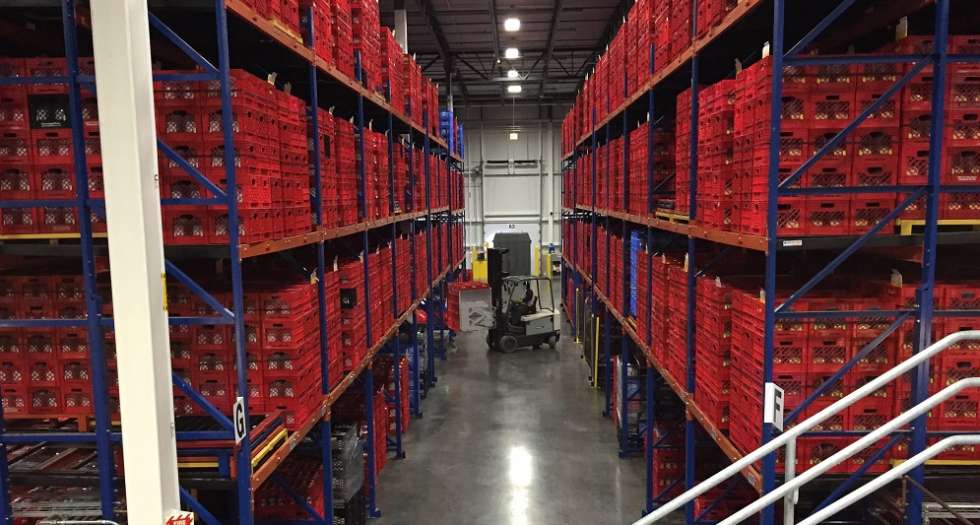Grocery is evolving…this comes as no surprise but how grocery stores are re-structuring in 2019 and beyond answers many distribution and fulfillment questions. Customers expect more than ever from retailers and providing the best customer experience is paramount to success. Grocery shopping is no longer a chore but an event! Grab groceries, cooked meals, a drink at the bar or local cooking tips all from one location. Four grocery store trends in 2019 include eCommerce/automation integration, smaller store footprints, evolving customer experiences and a frozen food renaissance.
1) Ecommerce/Automation – The online retail revolution is changing supply chains, as we know them. Customer acquisition costs and diverse product offerings are propelling the sprint for automation integration throughout the supply chain. The ability to provide larger and larger product mixes, in the right amount based on market demand, is a major area where automation can directly benefit fulfillment and distribution processes. With e-commerce continuing to grow at a rapid rate, the implementation of automated processes and warehouse management systems is more important than ever.
supply chains, as we know them. Customer acquisition costs and diverse product offerings are propelling the sprint for automation integration throughout the supply chain. The ability to provide larger and larger product mixes, in the right amount based on market demand, is a major area where automation can directly benefit fulfillment and distribution processes. With e-commerce continuing to grow at a rapid rate, the implementation of automated processes and warehouse management systems is more important than ever.
Automated systems move more product in and out and can complete some tasks 10x quicker than employees, but the scalability is still not ideal for many businesses. With an advanced inventory management system, inventory levels are maximized to meet customer demand while managing inventory levels down to the last detail.
2) Smaller Store Footprint – Brick and mortar grocery stores are beginning to shrink their store footprint by utilizing more effective inventory management tools that measure customer trends and maximize product exposure. With better data, stores can utilize specialized floor layouts to maximize visibility of high demand products. This evolution to a customized shopping experience based on analytics from local consumer buying behaviors enables grocery stores to decrease on hand inventory while increasing their capacity to fulfill online orders and store pickup.
The shift to ecommerce fulfillment for grocery means smaller customized SKU counts catering to specific local markets. Clustering products in store is another way companies can cater to customer buying habits, local grocery trends and seasonal changes. Clustering organics, dinners and fresh food creates a unique in store experience that will keep customers coming back. Clustering dinners with sauces and other ingredients is a convenient and personal way to appeal to a specific customer base while controlling the size of the operation.
3) Customer Experience – Customer experience…one stop shop… community. Redefining the customer experience to create a place to come together not only for food but also for a community experience like no other is a major focus for many grocery chains. No longer is the in store experience solely about stocking the right items. Many brick and mortar locations are redefining the customer experience to include such things as in store cooking lessons, wine tastings, full bars, juice bars, health clubs and even music venues! The new “grocery” store provides a place for the community to come together and can be customized to appeal to local demographics. Whether it is a concert venue in Austin or a health club in Los Angeles, food retailers are finding new ways to become one-stop shops for everyone.
community. Redefining the customer experience to create a place to come together not only for food but also for a community experience like no other is a major focus for many grocery chains. No longer is the in store experience solely about stocking the right items. Many brick and mortar locations are redefining the customer experience to include such things as in store cooking lessons, wine tastings, full bars, juice bars, health clubs and even music venues! The new “grocery” store provides a place for the community to come together and can be customized to appeal to local demographics. Whether it is a concert venue in Austin or a health club in Los Angeles, food retailers are finding new ways to become one-stop shops for everyone.
Tech integration is enabling stores to offer convenient buying options such as online orders and curbside pickup. These added capacities provide an omni-channel approach to customer engagement and convenience. No matter where you buy or how you buy, stores now have the technology to keep costs down by integrating the supply chain and offering maximum convenience for the ultimate grocery buying experience.
4) Frozen Foods – The unhealthy stigma of frozen foods is going away and evolving into something much more fresh and progressive. As organic and healthier food brands scramble to change the frozen food narrative, grocery stores are re-designing the display and marketing strategy for  customers. New research is changing customer views on certain frozen options that can be incorporated into healthier diets. With this change in consumer attitudes, stores are focusing on a healthy balance of fresh and frozen options for the time strapped customer on the go.
customers. New research is changing customer views on certain frozen options that can be incorporated into healthier diets. With this change in consumer attitudes, stores are focusing on a healthy balance of fresh and frozen options for the time strapped customer on the go.
Research and healthier branding supply grocery stores with a significant advantage because of longer shelf lives and less spoilage of product. With healthier options and more nutrition transparency, brands are turning the tide on frozen food adoption and carving out a nice position in the health food market. Combining the nutrition of fresh foods with the convenience of healthy frozen foods provides a customized buying experience specific to lifestyle and dieting needs.

